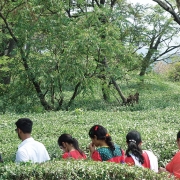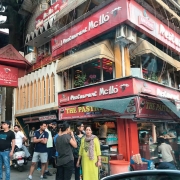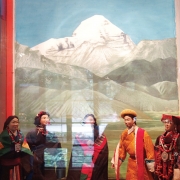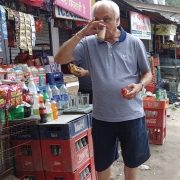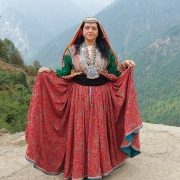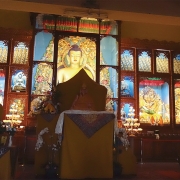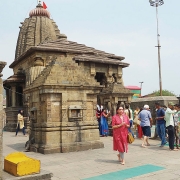
Etcetera
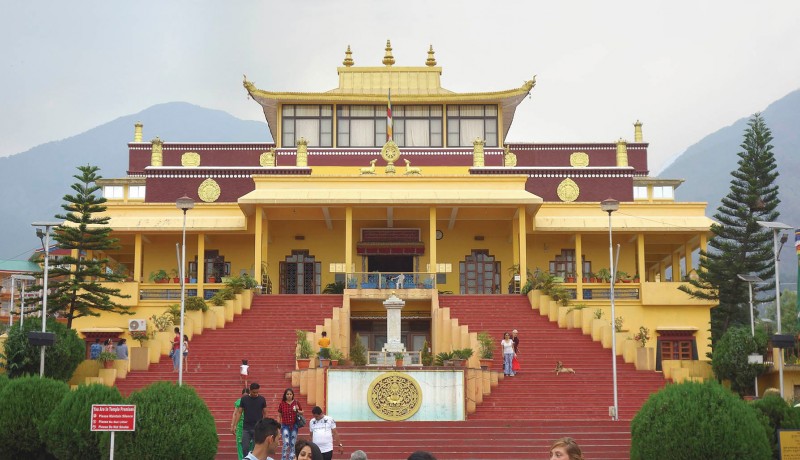
Dharamshala is a fascinating mix of art, heritage and natural beauty
There is a curious sense of peace that prevails in Dharamshala. Perhaps it has to do with its sheer provincial charm enhanced by the scenic hilly environs of Kangra district in Himachal Pradesh.
The calm was palpable immediately upon touchdown at Gaggal, the airport that serves the town and all of Kangra Valley. The airstrip amid the Dhauladhars or ‘milky mountains’ is so small that there is a landing facility for only turboprop aircraft. The airport’s limited passenger capacity and sleepy milieu were a far cry from the frenzied activity of the Delhi terminal, which was our point of departure.
We took in the fresh air, albeit surprisingly warm. Our friendly cab driver assured us in his Pahari accent, “This summer has been hotter than ever before, but 12 km more and we will be higher up in Dharamshala, which is cooler.”
I observed a sign to Palampur, a town best known for its tea gardens, which lies 38 km south of Gaggal. However, the largest gardens are in Dharamshala, owned by the Mann family, whose ancestors arrived in 1882 and set up Dharmsala Tea Company. Although, the region is traditionally known for green tea, its black tea is comparable to Darjeeling Kangra Tea, and is exported.
The road wound higher through hillsides clothed with pine trees. Taking the final turn before approaching our hotel, we saw buildings with colourful roofs perched on a higher spur across the valley. “That is McLeod Ganj. They say the Dalai Lama was in residence yesterday,” our self-styled guide piped up. He had good reason to convey this piece of information. Besides being the district headquarters and second winter capital of Himachal Pradesh, Dharamshala has drawn international attention since 1959, when Tenzin Gyatso, the 14th Dalai Lama, was compelled to leave Tibet and establish his administration-in-exile here.
Dharamshala has another claim to fame: its unique cricket ground under the auspices of the Himachal Pradesh Cricket Association (HPCA) is ringed by snow-spangled mountains and makes a spectacular venue for this much loved sport. It caught the public imagination in 2005 when the India-Pakistan ‘icebreaker’ match was played here.
We chose to stay at The Pavilion, an atmospheric hotel owned by the HPCA, situated on a forested hilltop. It has a well-appointed spread of chalet-style guestrooms. Ours was the ‘Wanderers’ block, named after the Namibian cricket ground in Windhoek. From the hotel terrace, we could easily identify the stadium by its distinctive Tibetan style roofs over the pavilion end. In the distance, paragliders in colourful parachutes were floating down the sky. They were enjoying the sport at nearby Bir Billing that qualifies to hold the paragliding world championships with its perfect height, landing spots and just the right wind velocity.
The entire district, as we were to discover, has several offerings. Its multilayered history creates an intriguing melange of culture that makes for some interesting sightseeing. The choices are so immense that we had to pick our preferences.
Kangra Valley’s proximity to the Himalayan passes has attracted several invaders. Greek king Alexander the Great fought King Poros here, identified by historians as Paramanand Chandra of the Katoch family lineage that ruled for over two millennia. The kingdom was so wealthy that Kangra fort was looted several times. Some romantics believe that treasure from Mahmud Ghazni’s attack (AD 1009) lies buried in one of the wells. In 1821, Sansar Chand Katoch was compelled to sign away much of his powers to Maharaja Ranjit Singh of Punjab. Then came the British annexation in 1848; they set up a cantonment. It is believed that a pilgrims’ rest house or dharamshala stood at the site, which is how the township got its name.
By 1860, Dharamshala had become a base for the 66th Light Infantry, later known as the 1st Gurkha Rifles. The colonisers built an assembly house, a post office and church, besides bazaars in Forsythganj and McLeod Ganj. The area flourished and the tea gardens yielded green gold. Lord Elgin, governor-general and viceroy in 1861, even proposed that the summer capital be made here. However, in 1905, a deadly earthquake reduced this paradise to rubble and panic-stricken settlers abandoned the area. British history has, therefore, been virtually obliterated and what remains today are ancient Hindu influences, together with a living Buddhist culture.
We made a start with a visit to Norbulingka Institute, designed to train and educate displaced Tibetan youth in the arts and provide employment. Its classic Tibetan architecture is laid out along the concept of Avalokitesvara, goddess of compassion and Tibet’s patron deity. The main temple hall represents the head of the goddess. It faces a charming Japanese-style bridge over a water body that symbolises the flow of kindness, and the buildings fan out as the several arms of the goddess. Through meandering paths, with prayer flags fluttering in the shady trees, we toured the workshops where students learn thangka (Tibetan Buddhist) painting, statue making and metal craft, wood carving, screen printing and tailoring. Later, we entered the ‘Seat of Happiness’ temple hall to gaze at the 14-ft gilded statue of the Buddha. Next, the Losel Doll Museum took us through a journey into Tibetan life through a diorama using miniature doll displays. After browsing through the Norbulingka shop and a quick coffee at the idyllic cafe, we set out for McLeod Ganj.
On our drive uphill, we halted a few kilometres short of our destination to see the last vestiges of colonialism, the ancient Gothic church, St John in the Wilderness. Ironically, Lord Elgin met his end in the very region he loved, succumbing to a heart attack while touring Dharamshala in 1863. His cemetery looked rather forlorn, shrouded in silence amid tall deodar trees.
At McLeod Ganj, the surge of humanity took us by surprise. Extricating ourselves from a traffic jam, we walked through the main bazaar, overwhelmed by a motley mix of honeymooners, tourists and backpackers. Monks in scarlet robes dotted the narrow lanes. We traversed the Kalachakra temple with its beautiful tiered roofs and wove through streets lined with shops selling votive objects, thangka paintings, carpets and beaded jewellery, among others. While the colour and character of this microcosm of Tibet was fascinating, the milling crowds and confusion generated a mind change. We decided to forego attractions such as Tsuglagkhang monastery, the Tibetan library and museum, and Namgyal monastery, the Dalai Lama’s personal sanctum.
We managed a quick lunch of unexpectedly good sizzlers and cutlets at McLlo, a four-storey, multi-cuisine restaurant and beer bar at McLeod Ganj. The town has an amazing repertoire of bakeries and Italian, French and Japanese restaurants. If it weren’t for the warm weather, I would have tried local Tibetan thupka, a typical bowl of soup with noodles that is a meal in itself. After lunch, our cabbie recommended we return to Dharamshala to see Gyuto Monastery before closing time.
En route, we took a stop at Dal Lake. As the name is evocative of Kashmir’s Dal Lake, expectations were high. Sadly, its shrunken green waters were rather disappointing, save for the picturesque slopes at the far end, forested with coniferous trees. A small lakeside Shiva temple added some charm. Makeshift stalls selling trinkets and snacks lined the hillside. Two rosy-cheeked local girls did good business dressing women tourists up in tribal gowns with heavy silver ornaments and printing out instant photographs.
Gyuto Monastery, known for its study of Tantric meditation, was founded in Tibet in 1474, and later rebuilt in Dharamshala by the Japanese to honour the Dalai Lama. We ascended the wide sweep of polished red steps, arranged in perfect symmetry, to go up to the main chamber, which has a grand statue of the Buddha. While we tiptoed in silence, the evening lights came on, casting multicoloured hues in the altar alcoves, leaving us spellbound.
Over the next few days, we focused on visiting some temples filled with mythological lore. The quaint Aghanjar Maha Dev Temple, ensconced in green foothills, is supposed to be the spot where Arjuna meditated on Lord Shiva, who granted him a boon of victory over the Kauravas. The largest Shiva temple, Baijnath, entailed a 50-km drive from our hotel, going downhill towards Palampur. As our car negotiated narrow bridges over pebbled rivulets, we passed by tea gardens and summertime hibiscus flowers peeping over fences. This 13th-century temple, with its shikhara rising heavenwards, has a special aura.
Closer to Dharamshala, by the banks of the Ban Ganga River, we visited Chamunda Devi temple, where she is worshipped with her consort, Lord Shiva. The goddess is believed to have vanquished demon brothers Chanda and Munda at this spot.
Beyond temple bells and Buddhist chants, this region of tranquil charm has inspired a flourishing of art. Not far from Palampur is Andretta, a village that developed as an artists’ haven under Norah Richards, an Irish actor who enriched Punjabi theatre. Padma Shri Sardar Sobha Singh, who had his residence-cum-studio here, created several masterpieces including signature paintings of Punjabi folklore lovers Sohni Mahiwal and Heer Ranjha. This bucolic hamlet has also attracted art in pottery, including Andretta Pottery and Craft Society, run by Mansimran Mini Singh, son of Gurucharan Singh of Delhi Blue Pottery.
The region’s art history dates to the times of Katoch dynasty. Under King Sansar Chand, the Pahari or Kangra School of Art reached its prime. He encouraged artists to depict themes of celestial Radha-Krishna love. The paintings are set in nature landscapes inspired by the region.
Given this vast spectrum of art, culture and philosophy vying for attention, our brief holiday turned out to be packed with a schedule of scenic drives and destinations. Still, it did not subvert that sense of being in an unhurried land, a satiating getaway from the city humdrum. Of course, there is noise and flurry in local markets such as Kotwali bazaar, with its tangle of shops and knots of traffic near the bus station. Then again, modernisation is making rapid strides.
On my way back, I was left wondering whether this town would retain its character while ushering in development. Back in Delhi, in the midst of the cacophony, the answer came to me: those colourful imprints of history will never fade. The stately Dhauladhars will forever look on. Dharamshala, like its name, will always remain a restful place.
FACTFILE
WHEN TO GO
To enjoy the mountain nip, it is better to visit Dharamshala early summer, during late March/ April. This will also ensure you do not get trapped in the holiday rush. For those who like winter snow, December–February would be ideal as the Dhauladhars are spectacular.
GETTING THERE
By air: Flights to Gaggal are only from Delhi. From the rest of India, a connection has to be taken through Delhi.
By rail: Overnight trains go from Delhi to Pathankot, the nearest railhead, which is 87 km away.
By road: Buses or taxis can be taken from Amritsar, 188 km away, or Jalandhar, which is 192 km away.
ACCOMMODATION
Hotel The Pavilion: Tel: 0189-2246006
The Quartz: Tel: (0) 9882340444
Text & Photos: Rekha Sarin Featured in Harmony — Celebrate Age Magazine December 2018
you may also like to read
-
Cracking the longevity code
Small yet impactful choices can be game-changers, writes Srirekha Pillai At 102, there’s no stopping Chandigarh-based Man Kaur, the world’s….
-
Home, not alone
While a regulatory framework is vital for senior-care facilities, the need of the hour is to develop an ecosystem to….
-
Birthday Girl
Published in a special edition to honour Japanese master storyteller Haruki Murakami’s 70th birthday, Birthday Girl (Penguin; Rs 100; 42….
-
A huge treat for music lovers
Published as the revised and updated second edition, Incomparable Sachin Dev Burman (Blue Pencil; Rs. 599; 470 pages) the authoritative….



